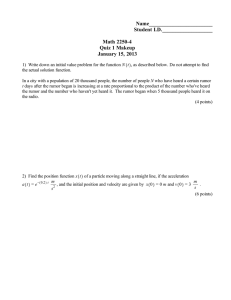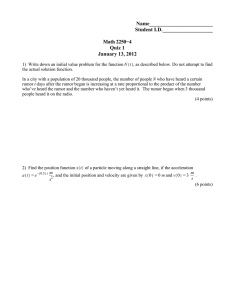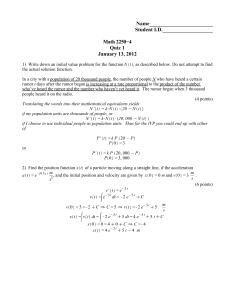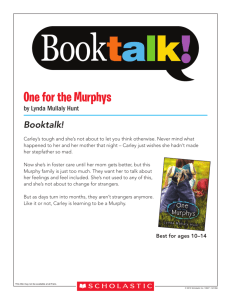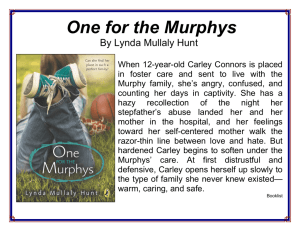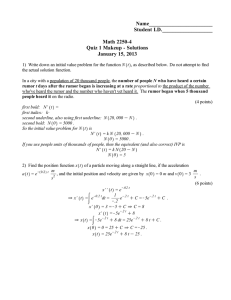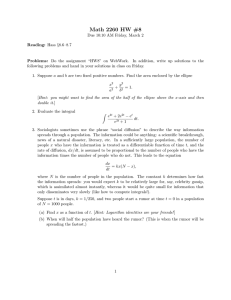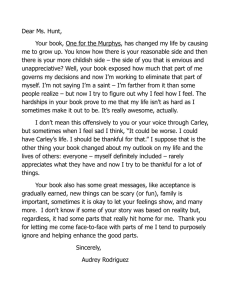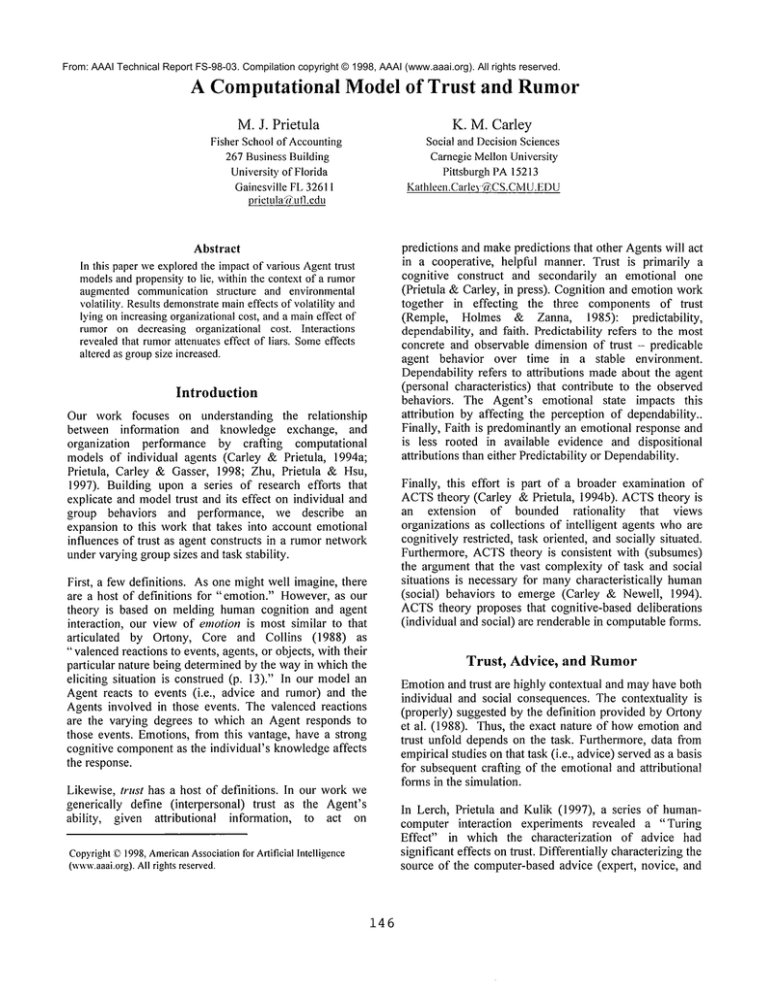
From: AAAI Technical Report FS-98-03. Compilation copyright © 1998, AAAI (www.aaai.org). All rights reserved.
A Computational Model of Trust and Rumor
M. J. Prietula
Fisher Schoolof Accounting
267 BusinessBuilding
University,of Florida
Gainesville FL32611
prietula’~’.ufl.edu
K. M. Carley
Social and DecisionSciences
CarnegieMellonUniversity
Pittsburgh PA15213
Kathleen.Carlev’?ZCS.CMU.EDU
Abstract
In this paperweexploredthe impactof various Agenttrust
modelsand propensityto lie, within the contextof a rumor
augmentedcommunicationstructure and environmental
volatility. Resultsdemonstrate
maineffects of volatility, and
lying onincreasingorganizationalcost, and a maineffect of
rumoron decreasing organizational cost. Interactions
revealedthat rumorattenuateseffect of liars. Someeffects
altered as groupsize increased.
Introduction
Our work focuses on understanding the relationship
between information and knowledge exchange, and
organization performance by crafting computational
models of individual agents (Carley & Prietula, 1994a;
Prietula, Carley & Gasser, 1998; Zhu, Prietula & Hsu,
1997). Building upon a series of research efforts that
explicate and modeltrust and its effect on individual and
group behaviors and performance, we describe an
expansion to this work that takes into account emotional
influences of trust as agent constructs in a rumornetwork
undervarying groupsizes and task stability.
First, a few definitions. As one might well imagine, there
are a host of definitions for "emotion." However,as our
theory is based on melding human cognition and agent
interaction, our view of emotion is most similar to that
articulated
by Ortony, Core and Collins (1988)
"valenced reactions to events, agents, or objects, with their
particular nature being determined by the wayin whichthe
eliciting situation is construed (p. 13)." In our modelan
Agent reacts to events (i.e., advice and rumor) and the
Agents involved in those events. The valenced reactions
are the varying degrees to which an Agent responds to
those events. Emotions, from this vantage, have a strong
cognitive componentas the individual’s knowledgeaffects
the response.
predictions and makepredictions that other Agentswill act
in a cooperative, helpful manner. Trust is primarily a
cognitive construct and secondarily an emotional one
(Prietula & Carley, in press). Cognition and emotion work
together in effecting the three components of trust
(Remple, Holmes & Zanna, 1985): predictability,
dependability, and faith. Predictability refers to the most
concrete and observable dimension of trust - predicable
agent behavior over time in a stable environment.
Dependability refers to attributions madeabout the agent
(personal characteristics) that contribute to the observed
behaviors. The Agent’s emotional state impacts this
attribution by affecting the perception of dependability..
Finally, Faith is predominantly an emotional response and
is less rooted in available evidence and dispositional
attributions than either Predictability or Dependability.
Finally, this effort is part of a broader examination of
ACTStheory (Carley & Prietula, 1994b). ACTStheory
an extension of bounded rationality
that views
organizations as collections of intelligent agents whoare
cognitively restricted, task oriented, and socially situated.
Furthermore, ACTStheory is consistent with (subsumes)
the argumentthat the vast complexity of task and social
situations is necessary for manycharacteristically human
(social) behaviors to emerge (Carley & Newell, 1994).
ACTStheory proposes that cognitive-based deliberations
(individual and social) are renderable in computableforms.
Trust,
Advice,
and Rumor
Emotionand trust are highly contextual and mayhave both
individual and social consequences. The contextuality is
(properly) suggested by the def’mition provided by Ortony
et al. (1988). Thus, the exact nature of how emotion and
trust unfold depends on the task. Furthermore, data from
empirical studies on that task (i.e., advice) servedas a basis
for subsequent crafting of the emotional and attributional
forms in the simulation.
Likewise, trust has a host of definitions. In our work we
generically define (interpersonal) trust as the Agent’s
ability, given attributional
information, to act on
In Lerch, Prietula and Kulik (1997), a series of humancomputer interaction experiments revealed a "Turing
Effect" in which the characterization
of advice had
significant effects on trust. Differentially characterizing the
source of the computer-based advice (expert, novice, and
Copyright
©1998,American
Association
for ArtificialIntelligence
(www.aaai.org).
Allrightsreserved.
146
expert system) affected howthe receiver trusted the advice.
Furthermore, evidence revealed that the cause for this
Turing Effect is based on how specific attributions were
made regarding the Situation, Knowledge,and Reasoning
and certain effects are time-dependent (Lerch, Prietula,
Kim& Buzas, 1998). Predictability impacts Dependability,
and Dependability impacts Faith. Both direct experience
and informationabout the source of advice affect trust.
Rumor(or gossip) generally involves the provision
information by one agent to another about a third (Wittek
& Wielers, 1998). How is trust related to rumor?
Information impacts trust, and rumor spreads information.
Thus, both the content and timing of information
dissemination can potentially impact trust. The content and
timing of rumor is based on the results of Turing Effect
experiments. Emotional componentsimpact trust, and trust
has both and individual and social consequences. In our
model, a rumor about an Agent (here, always a negative
attribution) can result in changesin cooperation.
The Initial
Study
The basic task involved a set of five agents, where each
agent acquires an order for an item at the order stack, seeks
the item in a warehouse,retrieves that item, then proceeds
back to the order stack for the next request. Manipulations
were made at the group level (i.e., homogeneousAgents
within manipulation): Rumor(all assert, none assert rumor is a truthful opinion based on experience that an
Agent is a Liar), Disruption (all disrupt item locations
when retrieving, none disrupt - defining environmental
stability), and Benevolence(3 emotion-basedmodels).
Benevolence models defined emotional sensitivity to bad
advice, resulting in adjustmentto trust levels for an Agent.
The 3 models were: (1) always trusty, (2) trusty
untrusty, (3) trusty, risky, untrusty. Agents wouldhave
preference to ask (broadcast) if any Agent knows the
location of an item. In addition, the prior three
manipulationswere crossed with 5 levels of Liar ratios (no
Liar agents to all Liar agents). Liar agents, whenasked,
would lie about the location of a sought item. Dependent
variables were total Time (maximumnumber of moves for
any Agent in the group) and organizational Effort (total
number of movesby the group).
Results
and Conclusion
Main effects were found for Rumoron Effort (Rumor
reduced organizational Effort but not total Time);
Disruption on Time and Effort (Disruptive Agents
increased Effort and Time); Liars on Time and Effort
(Liars increased Effort and Time). Additionally, Rumor
interacted with the Liar manipulation (Rumor reduced
effect of Liar agents on Effort and Time). Nomain effects
were found for Benevolence.
147
Sometimestask environments are unstable and Agents may
easily (though not maliciously) disrupt it. In such cases,
communication capability
can actually
inhibit
organizational performance. Liars in an organization
reflect a "false disruption" and similarly impact
organizational performance. However, Rumorreduces the
organizational
cost of Liars. The lack of strong
Benevolence effects was seen to be a problem with
valence: all models were too forgiving and the task could
not tease out the emotional impact on trust. Subsequent
research will add less forgiving Benevolence models,
extend the time-frame for the task to allow emotional
impact to occur, and adjust Rumorsensitivity.
References
Carley, K. & A. Newell (1994). The Nature of the Social
Agent, Journal of Mathematical Sociology, 19(4), 221262.
Carley, K. & M. Prietula (Eds.) (1994a). Computational
OrganizationTheol3,. Hillsdale, N J: LawrenceErlbaum.
Carley, K. & M. Prietula
(1994b). ACTS Theory:
Extending the Modelof BoundedRationality. In K. Carley
and M. Prietula (Eds.), Computational Organization
Theoly (pp. 55-87). Hillsdale, N J: LawrenceErlbaum.
Lerch, J., M. Prietula, & C. Kulik (1997). The Turing
Effect: The Nature of Trust in Machine Advice. In P.
Feltovich, K. Ford and R. Hoffman(Eds.), Expertise in
Context: Humanand Machine (pp. 417-448). Cambridge,
MA: AAAI/MITPress.
Lerch, J., M. Prietuta,
J. Kim & T. Buzas (1998).
Unraveling the Turing Effect: MeaswqngTrust in Machine
Advice. Working Paper, Graduate School of Industrial
Administration, Carnegie Mellon University, Pittsburgh
PA.
Ortony, A., G. Clore &A. Collins (1988). The Cognitive
Structure of Emotions. Cambridge, England: Cambridge
University Press.
Prietula, M. & K. Carley (in press). Exploring the effects
of agent trust and benevolence in a simulated
organizationaltask. AppliedArtificial Intelligence.
Prietula, M., K. Carley & L. Gasser (Eds.) (1998).
Simulating Organizations: Computational Models of
Institutions
and Groups. Cambridge,MA: AAAI/MIT
Press.
Remple, J., J. Holmes&M. Zanna (1985). Trust in close
relationships.
Journal of Personality and Social
Psycholog); 49(1), 95-112.
Wittek, R. & R. Wielers (1998). Gossip in organizations.
Computational and Mathematical Organization Theory,
4(2), 189-204.
Zhu, D., M. Prietula,
M. & W. Hsu (1997). When
processes learn: Steps toward crafting an intelligent
organization. Information Systems Research, 8(3), 302317.

